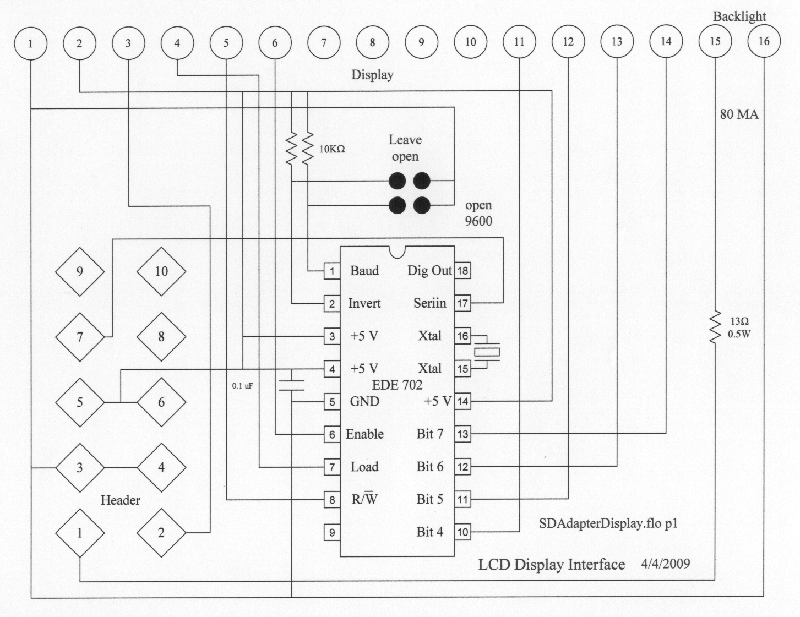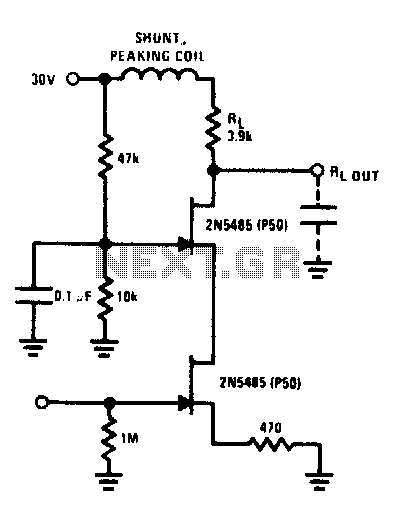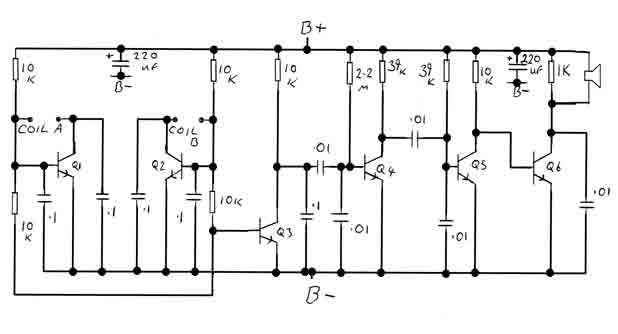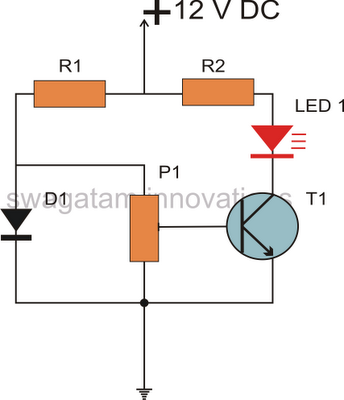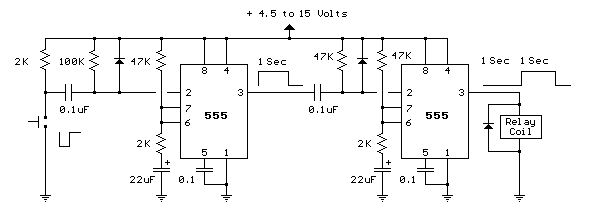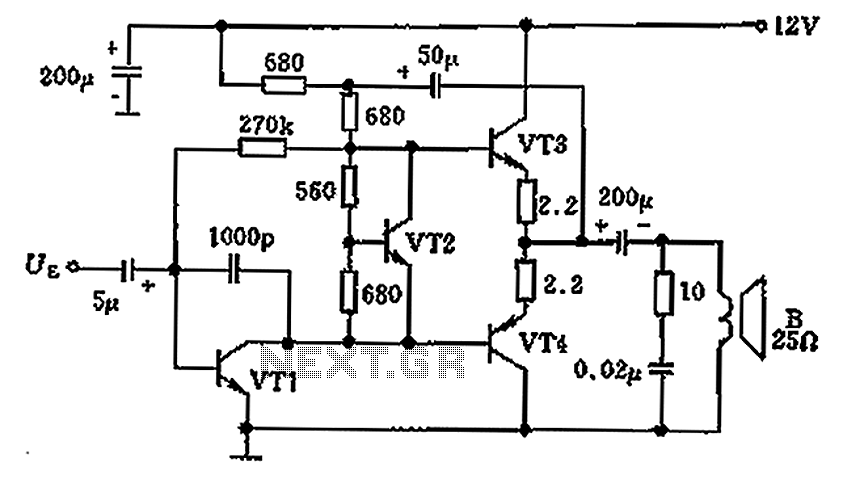
Complementary voltage switching Class D amplifier circuit
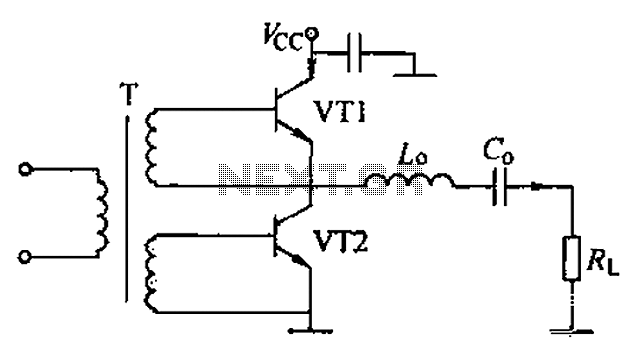
A complementary voltage switching Class D amplifier circuit is presented. Transistors VT1 and VT2 are 3DA12 types, while another transistor, VT3, is of the 3DK41C type. The collector is connected to a constant DC voltage of 12V. The input circuit utilizes a high-frequency transformer (T1) to generate square wave excitation voltages across VT1 and VT2. As both NPN transistors are configured in series, they operate in an alternating switch state, producing a square wave output voltage equal to the DC supply voltage. The circuit is designed with a high Q factor to select the fundamental frequency, which characterizes it as a voltage switching Class D amplifier.
The complementary voltage switching Class D amplifier circuit operates by utilizing two NPN transistors, VT1 and VT2 (3DA12), in a push-pull configuration. This arrangement allows for efficient switching between the two transistors, enabling them to alternately conduct and cut off. The third transistor, VT3 (3DK41C), is used to enhance the circuit's performance and stability.
The circuit is powered by a constant DC voltage of 12V, which is applied to the collectors of the transistors. The input signal is coupled through a high-frequency transformer (T1), which facilitates the generation of square wave excitation voltages. When the input signal is applied, it induces a magnetic field in the transformer, producing a corresponding output voltage that drives the base terminals of VT1 and VT2.
As the input signal oscillates, one transistor turns on while the other turns off, creating an alternating current (AC) output. This switching action produces a square wave voltage across the load, which is equal to the supply voltage. The high Q factor of the circuit is instrumental in determining the fundamental frequency, allowing for selective amplification of the desired signal while minimizing distortion.
This design is particularly advantageous for applications requiring high efficiency and compact size, such as audio amplification and RF transmission. The Class D amplifier's ability to handle high power levels with minimal heat generation makes it suitable for various electronic devices. Properly implemented, this circuit can deliver high-quality audio signals with reduced power consumption. Complementary voltage switching Class D amplifier circuit shown in Fig. Transistor VT1, VT2 are 3DA12. Among them, two of the same type (NPN) tube series product transistor VT is 3DK41C. Collector plus a constant DC voltage VLr 12V: an input circuit through the high-frequency transformer Tl, so I. this tube VI. 1 and anti-VT2 get to the square wave excitation voltage. Due to increase in both series n ij Journal (NPN) transistor input terminal of the voltage is large enough and the opposite phase, two tubes in switch state and alternately turned on.
Voltage across the circuit to a square wave. Size equal to the DC supply voltage V (Jc.k, cJ series circuit composed of a high Q to select the fundamental frequency. Therefore, this amplifier is referred to as the voltage switching Class D amplifiers .
The complementary voltage switching Class D amplifier circuit operates by utilizing two NPN transistors, VT1 and VT2 (3DA12), in a push-pull configuration. This arrangement allows for efficient switching between the two transistors, enabling them to alternately conduct and cut off. The third transistor, VT3 (3DK41C), is used to enhance the circuit's performance and stability.
The circuit is powered by a constant DC voltage of 12V, which is applied to the collectors of the transistors. The input signal is coupled through a high-frequency transformer (T1), which facilitates the generation of square wave excitation voltages. When the input signal is applied, it induces a magnetic field in the transformer, producing a corresponding output voltage that drives the base terminals of VT1 and VT2.
As the input signal oscillates, one transistor turns on while the other turns off, creating an alternating current (AC) output. This switching action produces a square wave voltage across the load, which is equal to the supply voltage. The high Q factor of the circuit is instrumental in determining the fundamental frequency, allowing for selective amplification of the desired signal while minimizing distortion.
This design is particularly advantageous for applications requiring high efficiency and compact size, such as audio amplification and RF transmission. The Class D amplifier's ability to handle high power levels with minimal heat generation makes it suitable for various electronic devices. Properly implemented, this circuit can deliver high-quality audio signals with reduced power consumption. Complementary voltage switching Class D amplifier circuit shown in Fig. Transistor VT1, VT2 are 3DA12. Among them, two of the same type (NPN) tube series product transistor VT is 3DK41C. Collector plus a constant DC voltage VLr 12V: an input circuit through the high-frequency transformer Tl, so I. this tube VI. 1 and anti-VT2 get to the square wave excitation voltage. Due to increase in both series n ij Journal (NPN) transistor input terminal of the voltage is large enough and the opposite phase, two tubes in switch state and alternately turned on.
Voltage across the circuit to a square wave. Size equal to the DC supply voltage V (Jc.k, cJ series circuit composed of a high Q to select the fundamental frequency. Therefore, this amplifier is referred to as the voltage switching Class D amplifiers .
